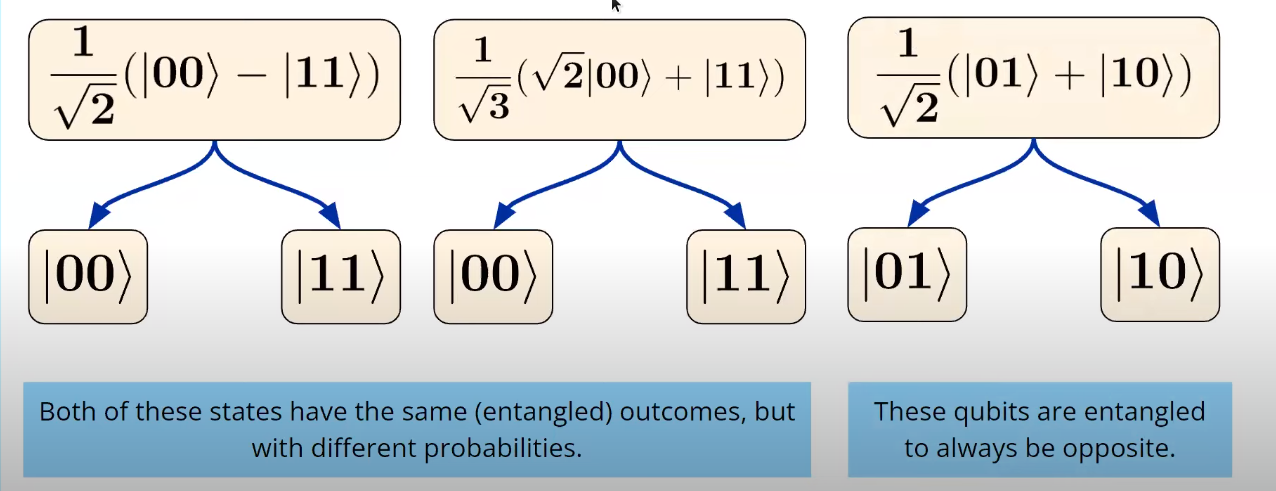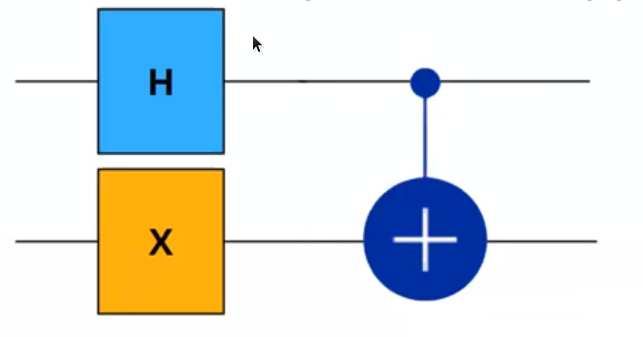Quantum Teleportation
Entanglement in Multi-Qubits

Example:
What is the state of the qubits after applying this circuit? 
- Consider two qubits as \(q_0\) and \(q_1\) each initialised at states \(\ket{0}\).
- H gate is applied to \(q_0\) and hence we obtain superposition state of \(\ket{+}\).
- X gate is applied to \(q_1\) and hence it changes to \(\ket{1}\)
-
In case of CNOT gate initially the state of \(q_0\) and \(q_1\) combine to give \(\ket{1+}\) which can expand to give
\[\frac{1}{\sqrt{2}}(\ket{10}+\ket{11})\] - After the combined multi-qubit state we have to apply CNOT. Here, \(q_0\) is the control bit and \(q_1\) as target. Hence, \(\ket{10}\) remains as it is as \(q_0\) is 0. In case of \(\ket{11}\), X gate is applied to the \(q_1\)part as \(q_0\) is 1 giving the changed state to \(\ket{01}\).
-
Finally, we can say the resultant of the circuit is
\[\frac{1}{\sqrt{2}}(\ket{10}+\ket{01})\]
Quantum Teleportation
QT is sending information more efficiently using quantum computers and sending classical bits. It is a protocol that transfers a quantum state from a sender at one location to receiver in a different location.
Limitations:
- Requires tow parties to share a pair of entangled qubits for every qubit to be teleported.
- It is not instantaneous and requires classical communication
- Used to send one qubit at a time not a complex object
Alice and Bob in QT:
- Alice and Bob share and entangled state and on their separate ways.
- Alice wants to send a special state to teleport to Bob.
- Alice measures half of the entangled state and her special state in the entangled basis.
- The measurement results are sent through classical channels.
- Bob adjusts his half of entangled state according to Alice’s measurements.
Mathematical approach to Alice and Bob Quantum Teleportation: 
- Consider Alice and bob both have qubits of state \(\ket{0}\) represented as \(\ket{00}\) such that the qubit belongs in this way \(\ket{Bob \ Alice}\) (same pattern is followed every where)
-
Entangling both the qubits and attaching a target qubit \(q_t\) we get:
\[\frac{1}{\sqrt{2}} (\ket{00} + \ket{11}) \ket{0}\]which is simplified as \(\frac{1}{\sqrt{2}} (\ket{000} + \ket{110})\)of pattern \(\ket{Bob \ ALice \ Target}\)
- Preparation of the special qubit: X gate is applied to \(q_t\). Hence we get \(\frac{1}{\sqrt{2}} (\ket{001} + \ket{111})\)
as X gate is applied to the target bit alone. -
Now Alice entangles the target bit with the previous part of entangled qubit which is done with CNOT gate given as:
\[\frac{1}{\sqrt{2}} (CX_{t,a}\ket{001} + CX_{t,a}\ket{111})\]After applying the CNOT gate:
\[\frac{1}{\sqrt{2}} (\ket{011} + \ket{101})\] -
H gate is applied finally, which can be represented as:
\[\frac{1}{\sqrt{2}} (H_t\ket{011} + H_t\ket{101})\]This can be simplified as below considering \(H_t\ket{1}\) is \(\ket{-}\) and which in bases of Z is given as \(\ket{0} - \ket{1}\)
Simplified to:
\[\frac{1}{2}(\ket{010} - \ket{011} +\ket{100}-\ket{101})\]Measurement is finally done to qubits with Alice .i.e \(q_{alice}\) and \(q_t\). Possible measurements are:
\[\begin{aligned} &\begin{array}{cccc} \hline \hline \text { Alice's Measurement } & \text { Bob's State }\\ \hline 00 & \ket{1} \\ 01 & -\ket{1}\\ 10 & \ket{0} \\ 11 & -\ket{0} \\ \hline \end{array} \end{aligned}\]Accordingly to get the \(q_t\) back Bob applies Z or X or both gates.